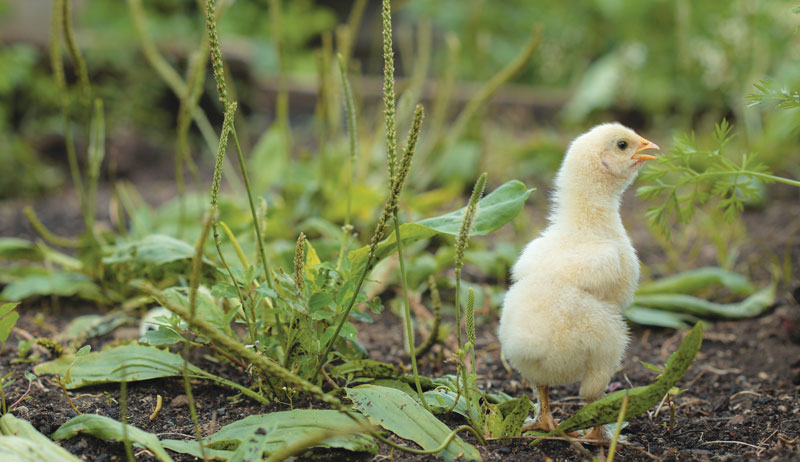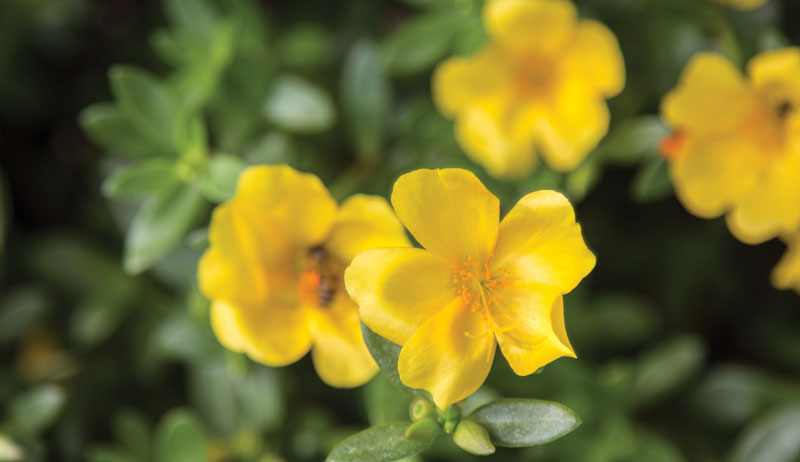
Chances are, there are wild plants growing near your home that are far more nutritious than greens you can buy. Your chickens will love these herbs, and so will you. You can stretch your chicken feed dollars by supplementing with wild plants that are free for the picking, and pecking at fresh plants gives chickens something fun to do. Best, many wild plants have medicinal qualities. Feed them to prevent illness and use them to put sick or injured chickens on the mend.
Let’s investigate easily-identified herbs that grow most everywhere in North America (and often the world) as nutritious treats for chickens.

Chickweed
Stellaria media
Other names: chickenwort, starwort, stitchwort, tongue grass and adder’s mouth
A hardy annual native to Europe, chickweed flourishes around the globe. It tolerates low temperatures, often blooming year round where temperatures rarely fall below 15 degrees Fahrenheit, and it prefers shady, moist locations and rich, neutral soil. Look for it in woodlands, meadows and waste places. It’s a common garden weed, too.
Chickweed is a mat-forming plant growing up to 12 inches tall, with oval-shaped, light green, 1⁄2– to 1-inch leaves, hairy stems and tiny, star-shaped white flowers. Chickweed has a long history of use as a nutritious edible green by humans and animals.
It’s a rich source of vitamins A, D, B complex, C, rutin (a bioflavinoid), calcium, potassium, phosphorus, zinc, manganese, sodium, copper, iron and silica. It contains six times the amount of vitamin C, 12 times more calcium and 83 times more iron than spinach.
Apply a poultice of chickweed for inflammation, abscesses, wounds and anything itchy. Internally, it’s a gentle laxative and soothing to the digestive tract. Chickweed is also a useful expectorant to loosen mucus.
Fun Fact: Sailors used chickweed vinegar to prevent scurvy when fresh citrus was unavailable.
Dandelion
Taraxacum officinale
Other names: wild endive, white endive, cankerwort and lion’s tooth
Everyone knows dandelion. A hardy perennial, dandelion originated in Eurasia, but European settlers brought dandelion to eastern America during the mid-1600s, where they cultivated it in their gardens for food and medicine. Today, it grows wild in all parts of the Northern Hemisphere, including the U.S. and southern Canada.
Dandelion’s long, deeply toothed, green leaves grow up in a rosette from the plant’s fleshy taproot, which, in the spring, sends up one or more naked flower stems, each terminating in a single yellow flower. The stem contains milky latex sap. Find it in abundance in gardens, lawns, pastures, waysides and waste places.
Every part of the dandelion is edible: leaves, roots, stems and flowers. Dandelions are an excellent source of vitamins A, C and K. They also contain vitamin E, folate and small amounts of other B vitamins as well as substantial amounts of several minerals, including iron, calcium, magnesium and potassium.
Dandelion is a potent anti-inflammatory and a natural pain reliever. It has antioxidant qualities and is used as a general health tonic. Many keepers feed dandelion with other herbs to their chickens as a laying stimulant, and its flowers produce bright-orange egg yolks.
Fun Fact: Seeds dispersed from a dandelion seed-head puffball can be carried up to 5 miles from their place of origin.
Read more: Dandelion is much more than a weed. Read about the plant’s many benefits!
Plantain
Plantago major
Other names: common plantain, broad-leafed plantain and soldier’s herb
Plantain is a common perennial found in lawns, gardens, along roadsides and in waste places around the world. Its thick, hairless, somewhat oval leaves grow up from a long, fibrous taproot, flaring out in a basal rosette along the ground. Six- to 18-inch flower stalks are tipped with spikes of tiny greenish-white flowers. A narrow-leafed variety, Plantago lanceolate, also known as ribwort, shares its nutritional and medicinal qualities.
Chickens love plantain, and humans can eat the young leaves, too, in salads or steamed like spinach. Plantain has been eaten in Europe for at least 4,000 years and was carried to North America by early settlers as a food plant and herb. It contains seven flavonoids, beta-carotene, crude and dietary fiber, fat, protein and carbohydrates as well as vitamins A, B1, B2, B3, C and K and calcium, chromium, iron, magnesium, manganese, phosphorus, potassium, selenium and zinc.
Plantain is antibacterial, antimicrobial, anti-inflammatory and a powerful antioxidant, and it’s especially noted for treating wounds and skin ailments. Make a quick poultice by chewing a few leaves and applying it to your chickens’ (or your own) skin disorders or injuries.
Fun Fact: Plantain is very durable and resists damage when walked upon, so it’s commonly found in high foot-traffic locations.
Purslane
Portulaca oleracea
Other names: little hogweed and pigweed

If you garden, you’re probably familiar with purslane. A summer annual, purslane trails across the ground, its succulent leaves spreading out, matlike, from a basal rosette like spokes on a wheel. Puslane’s prostrate stems grow up to 12 inches in length, while its smooth, shiny, mucilaginous leaves are green on top and pale purple underneath, growing 1⁄2 to 2 inches long. Find it growing in just about any location, including the cracks in sidewalks.
Native to East Asia, purslane came to our shores with early settlers as a potherb and herbal plant. It was first recorded in Massachusetts in 1672.
Purslane is an excellent source of vitamin A, one of the highest among leafy green vegetables. It’s also a rich source of vitamin C, and some B complex vitamins such as riboflavin, niacin, pyridoxine and carotenoids, as well as minerals such as iron, magnesium, calcium, potassium and manganese. Purslane leaves also contain more omega-3 fatty acids than any other leafy vegetable plant.
Will your hens benefit from purslane in their diet? You bet! Its drooping nature makes it ideal for hanging along run fences and henhouse walls. Or eat it yourself raw in salads or cooked like greens. The taste is similar to spinach or watercress. Purslane stores well. Its succulent leaves and stems stay fresh without refrigeration for several days after harvest.
Fun Fact: A single plant produces up to 240,000 seeds. Seeds are viable in the soil for up to 40 years.
Stinging Nettle
Urtisca dioica
Other names: common nettle

Perennial stinging nettle grows throughout the world, including all of the U.S. except Hawaii.
Nettles like rich, moist soil, so find them in dense clumps on marshy meadows and along woodlands, fence rows, stream beds and ditches. Nettle’s square, bristly stem grows from 2 to 7 feet tall and bears deeply serrated, pointed leaves that are downy underneath. Bristly hairs on the stem and leaves act like a hypodermic, injecting an irritant under the skin when touched.
Wear long sleeves, long pants and gloves when gathering or handling fresh nettles!
Technically, chickens consume raw nettles without harm, but it’s best to harvest nettles and allow them to wilt before feeding. Air wilting or steaming them, or boiling in plenty of water for a few minutes, neutralizes their sting
Several scientific studies indicate that due to their lutein and zeaxanthin content, feeding nettles to hens makes their eggs’ yolks a richer yellow.
Consider this:
- Spinach contains 102 milligrams of calcium per 100 grams (about a cup) while kale contains 206 milligrams. Nettles boast 2,900 milligrams of calcium by the same measure.
- Iron: 2.96 in spinach, 1.8 in kale, 41.8 in nettles.
- Magnesium: 96.8 for spinach, 37.4 in kale, and 860 in nettles.
Stinging nettle is also a fine source of chromium, cobalt, phosphorus, potassium, zinc, copper and sulfur, along with vitamins A, C, D, K and B complex.
Fun Fact: Nettle fibers have been used for thousands of years to weave nettle cloth. During World War I, German soldiers wore uniforms made of nettle cloth due to a shortage of cotton.
Gathering and processing wild plants is fun and rewarding. Plus, you might just find them very tasty too!
More Information
Feeding Greens
Feeding wild herbs to your chickens is a breeze. Gather them fresh, tie their stems together and hang them on chicken run fences or henhouse walls. You can also place them in feed troughs and let your birds have at ’em.
Another option is to dry them for winter use. Place them on paper towels over newspaper in a well-ventilated area out of the sun, arranged so the leaves or plants don’t touch one another. Hang-drying them is even easier. Bind their stems in small bundles, and hang them upside-down in the same sort of well-ventilated, shady area until dry.
Store dried herbs whole or loosely crumbled. Don’t crush them into powder prior to storing them. If an herbal recipe calls for powdered herbs, process the herbs just before mixing.
Store dried herbs in paper bags, cardboard boxes or glass containers but not plastic or metal. Keep them in a cool, dry place, out of direct sunlight. Mix dried herbs with your chickens’ normal food. Most chickens will also eat dried herbs if they’re served on the side in separate feed cups.
You can also loosely pack a quart canning jar with your favorite plant, cover it with boiling water, cap and let steep overnight, then add the nutritious herbal tea to water receptacles or sprinkle it over feed. With strong-tasting herbs such as dandelion, start with a small amount and add more as your birds become used to the flavor.
Read more: When & how should you harvest your herbs?
Harvest Help
Harvest herbs for your chickens in a safe, responsible manner. Buy a good wild-plant identification book with clear illustrations, and make sure you know what you’re picking. If you can’t positively identify a plant, don’t use it.
Pick only in areas that are free of chemicals and automotive exhaust. Avoid sprayed yards, parks and the sides of roadways. Pick in midmorning or later, when dew is off the plants. Dig most roots in late fall. Mark plants during their flowering phase so you can find them later when you need them.
Take only what you need and always leave some plants behind.
This article originally appeared in the July/August 2022 issue of Chickens magazine.




